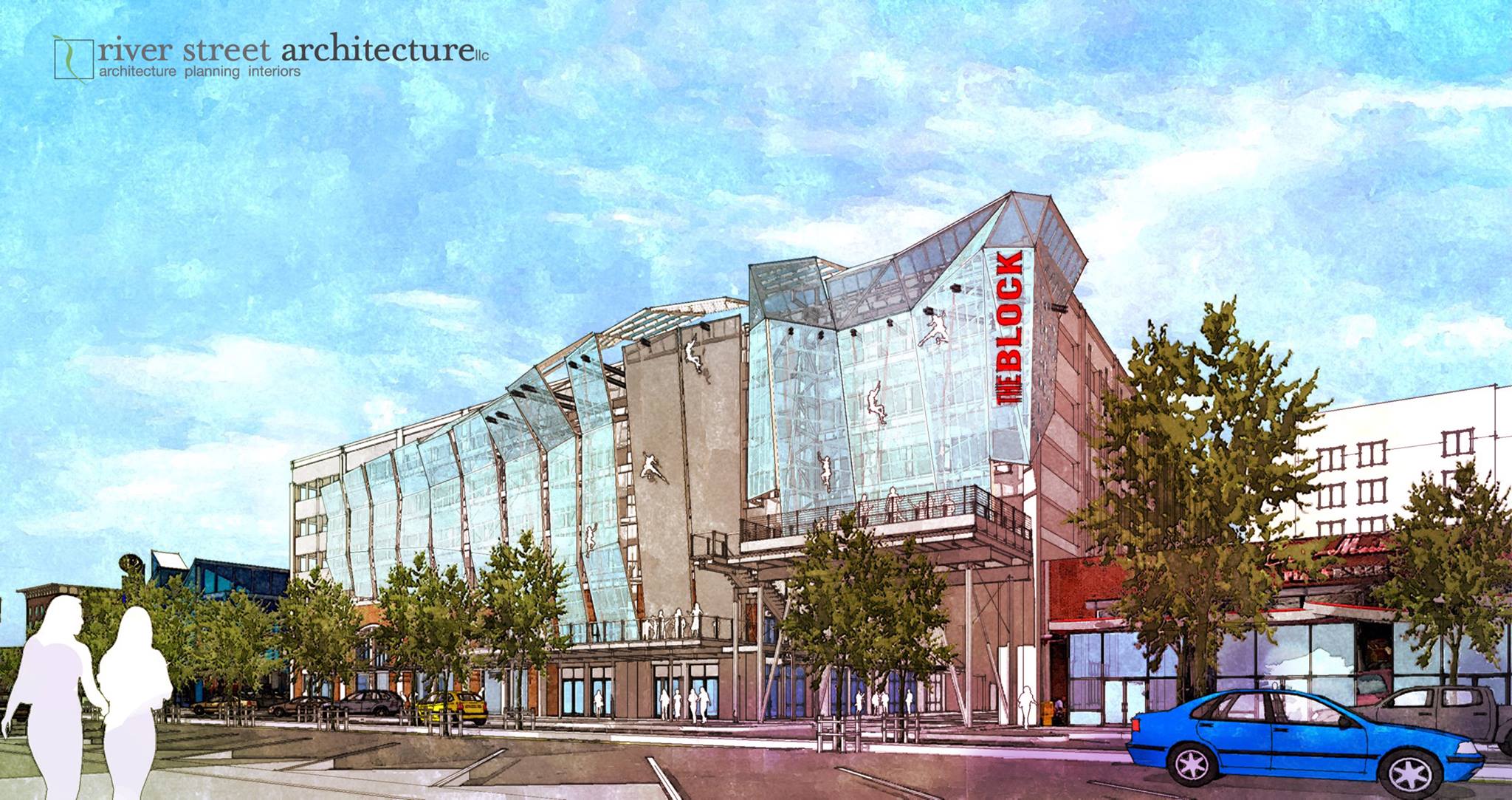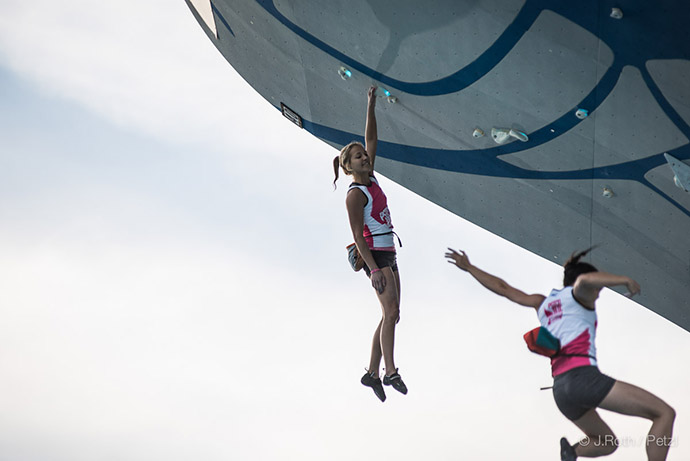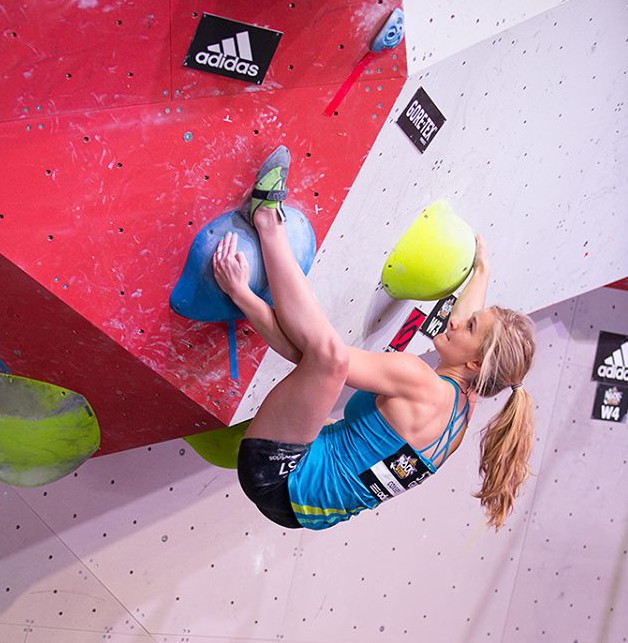
Video: Adidas Rockstar Finals

Accident Report Form
 There are two types of climbing facilities; those that have had an accident and those that will have an accident. After an accident managers often make changes to reduce the risk of another accident, either by updating their policies, reconfiguring equipment, improving staff training or modifying how they instruct members. These changes are valuable improvements to the climbing industry as a whole, but unfortunately there has not been an effective way to share these best practices. Until now.
Climbing Business Journal has just released the first ever Accident Report Form for indoor climbing facilities. The primary purpose of the Accident Report Form is to learn how an accident occurred and what changes could be made to prevent it from happening again. These lessons can then be shared with the indoor climbing community so that all facilities can learn how to prevent a similar incident.
The information from these forms may be shared on the Climbing Business Journal website and through the Climbing Business Journal’s Annual Report of Accidents. The goal of these reports is to help indoor climbing facilities improve the safety and of their facilities and reduce their risk and liability.
This accident form was inspired by the American Alpine Club’s annual Accidents in North American Mountaineering report. For years the AAC has been gathering and compiling mountaineering injuries and sharing the lessons learned with the mountaineering community. Their goal is “to help you learn from the mistakes of others so you can come home safely and climb tomorrow.” ��We think this is great resource and aim to replicate this tool for the indoor climbing community.
CBJ’s indoor climbing facility Accident Report Form is intended for reporting accidents at an indoor climbing facility that required emergency medical attention: injuries that resulted in an ambulance taking the injured parties to a hospital or the injured parties taking themselves to a medical facility immediately following the accident. The form is not for minor injuries that did not require medical treatment, such as a sprained ankle or skinned knee, or for chronic pain associated with the sport.
We understand that dealing with an accident can be a trying time. That is why we designed the form to be a simple one-page report of just the facts. The names of the people involved in the accident will not be collected, and disclosing the name of the gym is optional. What we care about is helping to find, and share, best practices that will improve the safety and viability of indoor climbing facilities.
Whether you run a large commercial climbing gym, a university wall or recreation center wall this form is for you. When you fill out the form your information will be compiled into a database that will be used to create a one-of-a-kind annual report for the indoor climbing industry. This annual report will give a snap-shot of the safety record of our industry and help all climbing facilities become safer facilities.
There are two types of climbing facilities; those that have had an accident and those that will have an accident. After an accident managers often make changes to reduce the risk of another accident, either by updating their policies, reconfiguring equipment, improving staff training or modifying how they instruct members. These changes are valuable improvements to the climbing industry as a whole, but unfortunately there has not been an effective way to share these best practices. Until now.
Climbing Business Journal has just released the first ever Accident Report Form for indoor climbing facilities. The primary purpose of the Accident Report Form is to learn how an accident occurred and what changes could be made to prevent it from happening again. These lessons can then be shared with the indoor climbing community so that all facilities can learn how to prevent a similar incident.
The information from these forms may be shared on the Climbing Business Journal website and through the Climbing Business Journal’s Annual Report of Accidents. The goal of these reports is to help indoor climbing facilities improve the safety and of their facilities and reduce their risk and liability.
This accident form was inspired by the American Alpine Club’s annual Accidents in North American Mountaineering report. For years the AAC has been gathering and compiling mountaineering injuries and sharing the lessons learned with the mountaineering community. Their goal is “to help you learn from the mistakes of others so you can come home safely and climb tomorrow.” ��We think this is great resource and aim to replicate this tool for the indoor climbing community.
CBJ’s indoor climbing facility Accident Report Form is intended for reporting accidents at an indoor climbing facility that required emergency medical attention: injuries that resulted in an ambulance taking the injured parties to a hospital or the injured parties taking themselves to a medical facility immediately following the accident. The form is not for minor injuries that did not require medical treatment, such as a sprained ankle or skinned knee, or for chronic pain associated with the sport.
We understand that dealing with an accident can be a trying time. That is why we designed the form to be a simple one-page report of just the facts. The names of the people involved in the accident will not be collected, and disclosing the name of the gym is optional. What we care about is helping to find, and share, best practices that will improve the safety and viability of indoor climbing facilities.
Whether you run a large commercial climbing gym, a university wall or recreation center wall this form is for you. When you fill out the form your information will be compiled into a database that will be used to create a one-of-a-kind annual report for the indoor climbing industry. This annual report will give a snap-shot of the safety record of our industry and help all climbing facilities become safer facilities. Largest Downtown Climbing Gym
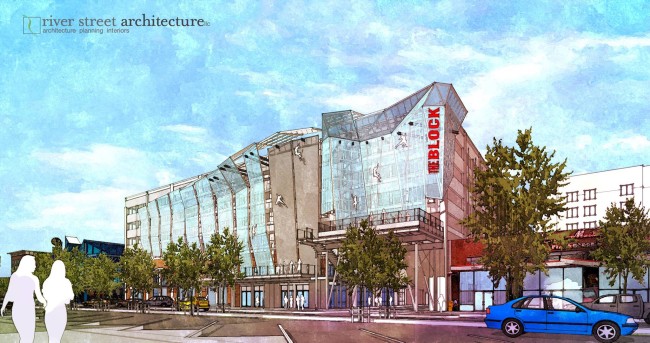
The project has ballooned by $2.5 million from its original projections, which called for a $4 million building. But doing something that’s never been done before isn’t easy, said Jim Williamson, vice president of planning and development for River City Co. Even finding a place for the 40-foot indoor climbing walls was a challenge. “For this to be a premiere site, they need to be at least 40 feet,” he said. “We only had 20 feet, and there are 600 cars above you so you can’t raise the roof.” So they dug out the concrete floor — an expensive, time-consuming process, but one that was a prerequisite to being taken seriously by the climbing community. The same pit can also be used to train emergency responders by inserting a length of drainpipe to simulate a well or other confined space into which a person might fall and require rescue.Get Out Chattanooga is reporting:
Not everyone is thrilled to see that downtown’s new landmark will be a climbing gym. “I believe that the High Point Climbing Gym will have an immediate effect on the other two climbing gyms that are operating in town,” says Rebecca Robran, co-owner of Urban Rocks Gym off of Amnicola Highway. “Chattanooga may grow to the point where it can sustain three commercial facilities but it is not there right now. The question is whether or not the existing mom and pop facilities can keep their doors open long enough to meet the market growth.” For their part, the Block creators say they don’t want to put anyone out of business and believe the gym will raise awareness of climbing and generate more interest for all of the area’s climbing facilities. O’Brien says Boulder, Colo. has four climbing gyms that are all thriving. “I think this will elevate everyone else,” Wheeler says. Robran is not convinced. “With Boulder as an example, there are four commercial facilities there but all the facilities were built not with the idea of potential growth in the town but because the existing facilities were severely overcrowded throughout the year,” she explains. “Chattanooga’s market has not reached that point for the two existing facilities yet.” Luis Rodriguez, who opened the city’s first climbing gym, Tennessee Bouldering Authority in 1999, says he is not worried. “We’re not going to be in direct competition at all,” he explains. “It’s not going to hurt us; it’s going to help us by raising awareness for climbing.” Rodriguez says TBA is set up more as a “basement, hole in the wall” bouldering gym than a flashy setup with rope and high walls. He hopes the gym will be a landmark and help bring a national or international climbing festival to the area. “It’s going to become like the Aquarium,” he says. “It’s going to be known as part of downtown.”
Sexism At Psicobloc?
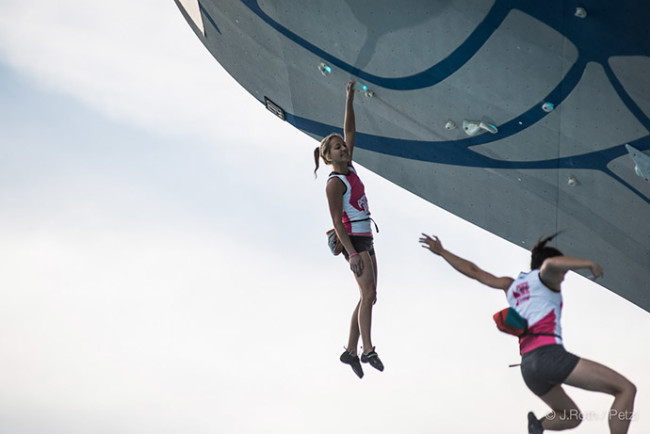
Originally Published at all-events.com
The Importance of a Good Emcee: Psicobloc Masters Series and sexism At the Outdoor Retailer Summer Market in Salt Lake City, Utah, there was a big climbing competition. What is usually a very high-production and live-streamed affair went big time this year. Walltopia designed a beautiful wall over the Olympic training pool for skijumpers, effectively creating a deep water solo competition up in Park City. The crowds ate it up. All of us watched the promotions for it, even if we weren’t into comps, and imagined either being there, or, if you’re an event producer who climbs, producing it. Unfortunately, I’m left with a bad taste in my mouth after watching the real thing from home. The event was rampant with disrespect for the viewers, the competitors, and, most importantly, women in the sport. Emcees have an important role in events: they keep the energy up for spectators – explaining what’s happening, color commentating on events or athlete backgrounds, make the competitors feel good about themselves, and are the face of the entire event for the public. Keeping the Energy Up During the course of the 20 min clip below, the emcees let dead air hang – only to be punctuated randomly by competitor’s names and words of enthusiasm like, “Yes!” When they did announce the action, it was in simplistic terms – there was no clarity for those of us watching, “Those of us out there, sport climbers know about the flash pump – it is not a fun thing.” What’s sport climbing? What’s a flash pump? Tell me, please! Again, Colette tries but fails: “Everyone should keep in mind, these are hard routes. They’re bad holds, people that maybe don’t climb a lot, it looks like they just reach up and grab the thing.” Really? That’s the best you can do to bring me into the experience? Can you tell me about the holds, about what it feels like, about what makes a hard route? Make me experience it. Use the climbers moving to help me envision it. Tell a story. Very little was said about the athletes themselves except when one gal had an ear injury and catch up on that, or if they were scared. The emcees would grab the competitors before and after, prompting things that were really vapid or simply ignorant: JT, “It felt a lot different from last time, right?” Competitor: “Not really.” Sigh . . . expand on it, people, make it interesting to us. Why did you assume it was different? Make the Competitor Feel Good JT put words in Alex Johnson’s mouth, but she handled it well. When it was her heat-mate’s turn to talk, JT gave her nothing but a “good luck.” Alex got all the attention and Nina, none of it. While these are prime athletes and slights like that should roll off their backs, his interactions did nothing to encourage focus and competition. The dominant conversation theme with the women was their fear, not so with the men. Ask any sport psychologist – focusing on a competitor’s weakness isn’t going to empower them. The Face of the Event Both JT and Colette announced the event like amateurs, disconnecting themselves from the event’s producers, saying things like “Whoever put this on . . . “ Ditsy comments; unorganized, badly timed comments. Bad interviews. It all felt like a terrible afterthought while I watched. You could laugh it all away, except these two were the representatives of Psicobloc and climbing to the general public. Whoever asked them to be a part of this really didn’t respect what they were putting out there or the people that competed or put it on. But there was a much bigger problem, more problematic to the climbing community than bad emceeing: rampant sexism. Events Send a Message to the Public Colette at one point exclaims, “I LOVE Andrea’s tan! I’m jealous.” Do golf or football announcers do things like this to serious athletes they’re commenting about? What about Andrea’s movement? Her form? Her commitment? At another point, Colette introduces an extremely sexist conversation point, complaining about the comp rash guards given to the women, “I can’t see their cute tops underneath!” JT picks up on this and says he’s going to “File a complaint because yesterday they were climbing in string bikini tops – so, whoever’s organizing this thing: come on!” No, YOU come on. Unless you’re going to file a complaint that Chris Sharma’s not climbing in a Speedo along with it. In later clips, the men are WAY more dressed and . . . it’s JUST NOT FAIR. I want to see muscles! But, it’s very easy to lay all the blame on the emcees they hired, but there’s a bigger factor at play, as revealed by the female emcee, Colette, 20 minutes into the clip: “Originally, they were going to cut out some of the women climbers. There were too many women climbers and they sent some of the women home, but in the end, all the girls said, ‘You know what, we want to compete, we’re all here – we’re going to compete’ and they ended up bringing all of the women back.” “They” decided there were too many women and they cut out the women? Thanks a lot, event producers. Climbing is very much a male-dominated sport, but the women climbing achieve at an equal level to men across most disciplines. Fans of climbing can likely name as many famous, accomplished women climbers as men. It’s not the WNBA here (a counterpoint to a long history of male-dominated sports, and an ineffective one), and there’s no reason to foster that attitude in the nascent climbing events distributed to the greater public worldwide. Sponsors of this event, do you hear me? Prana, Walltopia, Adidas, Clif, and all others – do you support the sexism displayed in this event? Will you continue to support marketing, media, and events that do not show a commitment to the equality and ability of your professional climbing women? You have the power to change this dialog – now is the time, before it’s too late. This is not the 1950s and 1960s. Our mothers were on the walls and in Camp 4 alongside the men so that we could be in these competitions today with the men. And not a single one of them would have let the guys treat them as badly as this comp treated their granddaughters. You can blame it on the emcees, but this goes a lot deeper and deserves some intelligent conversation. A link to the analyzed clip referenced in the article:
A New Softer Spot
http://www.coloradodaily.com/outdoor-recreation/ci_23905514/boulders-spot-climbing-gym-adds-180k-new-flooring
Falling at The Spot just got easier.
The Boulder climbing gym spent $180,000 to replace roughly 6,500 square feet of flooring, which is specially designed to withstand falls from the gym’s bouldering walls.
The new floor, made of heavyweight open-cell urethane with a vinyl cover, is significantly thicker in some places, going from 6 inches to 16 inches over most of the gym.
Owner Dan Howley said the new flooring system from company Futurist Climbing should be more durable and last for six years. The Spot has around 15,000 square feet of total climbing terrain, all of which is for bouldering, or non-roped climbing.
“For us, it’s quintessential,” Howley said. “In a roped climbing gym, the ropes are your main protection. In a bouldering gym, every fall is a ground fall. (The floor) is technically more important than the walls themselves.”
In the past, climbers have placed additional mats under their route for added protection. Howley said those mats aren’t necessary with the new, thicker floor.
“It’s much safer,” he said. “It’s consistent. It’s flat. The gym’s in the best shape ever.”
The Spot, which wasn’t actually closed during the floor replacement,
Pregnant? Why not go climbing?
https://mail.google.com/mail/u/1/?shva=1#inbox/140f6caa23530203
Rock Master Report
http://www.planetmountain.com/english/News/shownews1.lasso?l=2&keyid=41197
Canadian Gym on the Rise
http://www.guelphmercury.com/news-story/4066882-guelph-grotto-a-business-on-a-steady-climb/





